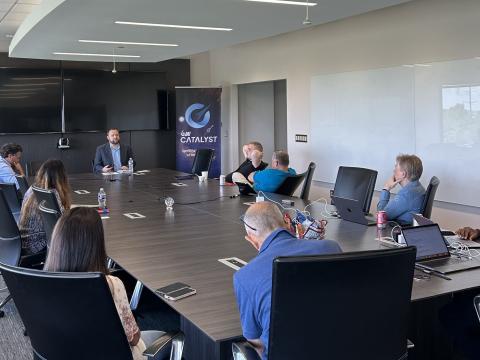Putting Satellites in Soldiers Hands
A veteran-led company designs satellite applications for mobile devices.
Jim Ramsey never dreamed he would become a leader in the satellite communications industry. He just wanted to be a soldier. But his U.S. Army superiors had other ideas. They decided to transfer him from infantry to combat support, specifically as an officer in the Signal Corps. Ramsey was anything but happy about his impending transfer in the late 1980s.
Today, as the president of fast-growing MTN Government Services, he is at the cutting edge of satellite technology critical for battlefield communications. The unit of privately held MTN Satellite Communications just became a prime contractor on a sprawling $5 billion joint program between the General Services Administration and the Defense Information Systems Agency that will run for at least a decade.
In the meantime, Ramsey is hardly resting on his laurels. Instead, he is working on new applications designed to provide soldiers with satellite communications on a wide range of smart, mobile devices.
“The question is, how do I give them something to carry that’s lighter, that’s going to battery-operate longer, that’s going to be a hell of a lot easier to use and is more effective for them?” he says. “That’s what I want to do.”
Ramsey joined the Army National Guard in his native Ohio in 1979. While attending Bowling Green State University, he became a commissioned Army officer and after graduation remained in the infantry.
If only he had not been promoted to captain. That is when his transfer to the Signal Corps came through. One would have thought they had busted him to buck private.
“The funny thing is I fought it and fought it and actually took it all the way to the commanding general,” Ramsey recalls. “I loved being an infantry officer. I loved jumping out of planes. I loved putting camo on my face. You know, I had no other dreams.
“As an infantry officer I was screaming at the Signal officers. And then, very shortly after that, I became a Signal officer and I was getting screamed at. But once I got transferred to the Signal Corps, I realized the ability to connect to the commanders on the battlefield was crucial. I really learned how important the Signal community was to the overall military fight, to what was going on in the battlefield.”
In all, the barrel-chested executive spent 25 years in the Army, retiring as a lieutenant colonel. Along the way, he served as an operations officer or commanded units within the 2nd Infantry Division, the 82nd Airborne Division and the White House Communications Agency (WHCA).
While at the White House, he served as a presidential communications officer for both presidents William J. Clinton and George W. Bush. Ramsey was responsible for planning, installing and maintaining communications for more than 1,000 presidential trips. His performance there led to his being inducted into the WHCA Hall of Fame in 2005.
“It was an incredible job,” he relates. “I got to travel places I never dreamed of in my life. I actually got to be in (Russian) President Vladimir Putin’s office in Moscow. You name it, we went there. I deployed to 183 different countries. And we faced almost any challenge you can imagine in communications, whether it was deploying to China or deploying to Africa.
“After I retired in 2004, President Bush appointed me as the CIO [chief information officer] of the G8 Summit. That was about an 18-month task. Honestly, it probably was one of the hardest things I ever did. We established all the communications for 34 world leaders in Sea Island, Georgia, a place that literally had hardly any infrastructure. So that was very challenging.”
Ramsey, who turned 51 on October 7, started MTN Government Services (MTNGS) from scratch in February 2009. The parent company is a global provider of satellite communications services for the aviation, commercial shipping and offshore energy markets among others.
Based in Leesburg, Virginia, MTNGS delivers turnkey, end-to-end solutions, managed satellite services and adaptable alternatives for the military and other government agencies. Services include solutions for legacy voice, voice over Internet protocol (VoIP), data, Internet and compressed video using very small aperture terminal (VSAT) technologies.
Because his company is privately held, Ramsey says he cannot provide sales or revenue figures. But he does say that MTN Government Services has grown from just Ramsey himself to nearly 40 workers today. That compares with about 300 for the corporation as a whole.
He estimates that the division now accounts for more than 20 percent of the parent corporation’s total sales. The government services division now has a global presence, and Ramsey wants to capitalize on this infrastructure by tripling sales in the next five years.
Last March, the federal contracting unit won its biggest award to date—a piece of the $5 billion Future Commercial Satellite Communications Services Acquisition (FCSA) contract. “That was a big win for us,” Ramsey notes. “Our sweet spot isn’t just flipping bandwidth. It’s our ability to take that bandwidth and provide subscription services behind it. We’re in a position now where we can go head-to-head with our big competitors in town.”
Ramsey says he personally has observed how much young soldiers in the Washington, D.C., area, enjoy using their mobile phones. He believes they would be just as careful with these devices out in the battlefield as well. To this new generation of tech-savvy young people, the phones play an essential role in their lives.
The devices hold their music collections, their photo collections and their videos from home. Today’s troops also use mobile phones to text friends and colleagues as well as to surf the Internet. And most of them also have a wide range of applications such as those for shopping, weather, games and recording music.
The New York Times estimates that Apple Computer’s popular iPhone has about 475,000 applications, or apps, and the company’s iPad tablet computer has more than 90,000 apps. The newspaper reports that the Palm Pre phone has about 8,000 apps. Adding in applications for Google’s Android mobile operating system brings the total to more than 600,000 apps for smart phones. Why, Ramsey wonders, can’t soldiers use a mobile app for satellite communications in the field?
“You know, as a Signal officer jumping with the 82nd Airborne in the middle of the night on a drop zone and trying to operate these satellite communications systems with power meters and spectrum analyzers and literally just trying to find a satellite in the middle of nowhere is very hard,” Ramsey says.
“So how do we take something very complicated in acquiring a satellite and be able to give it to our cook, our mechanic, our truck driver in the military so he or she can get on it and use it? The way we do that is we have to get to these kinds of app platforms that these young kids know how to use today without any hesitation.”
At press time, MTN was testing three prototype devices. Ramsey says the company is still trying to determine in what format the applications will be delivered. His best guess is that ultimately the company would bypass hardware-specific solutions in favor of software that could run on multiple devices. With the program still in the early stages, he would not predict when a final product would be fielded.
But as Ramsey sees it, this effort is part of a much larger paradigm of providing increasingly better services for the dollar in the era of tight Pentagon budgets. No doubt, the Defense Department must have excellent communications to achieve its goal of using real-time information as a force multiplier.
Moreover, he says, he personally values giving back to the defense community. He supports several military-related charities such as the Wounded Warrior Project and Operation Give A Hug, which provides comfort to children missing a parent.
“I’m very passionate about helping our military as they deploy because I’ve been there and I have that tee shirt,” he concludes. “But I also think we have an obligation to help those around us and those that come back from combat. We do a lot of that. It’s a big portion of what I do every day.”
WEB RESOURCE
MTN Government Services: www.mtngs.com



Comments